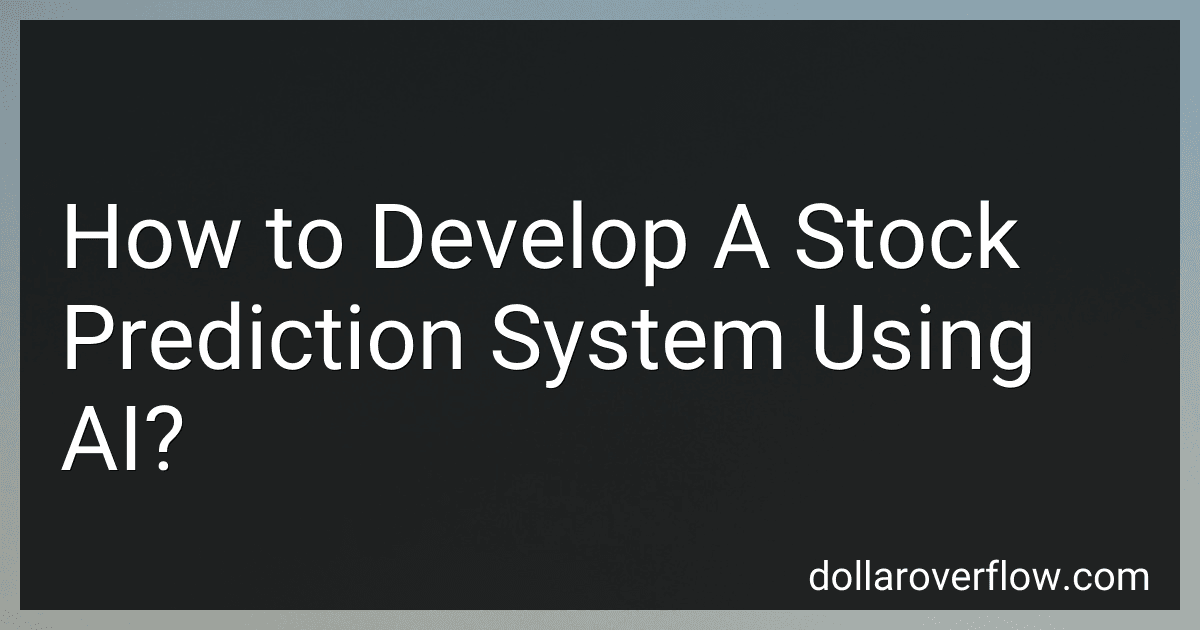Developing a stock prediction system using artificial intelligence entails integrating AI algorithms and machine learning models to analyze historical stock market data, identify patterns, and make forecasts on future stock prices.
The first step in building such a system involves collecting and preparing a large dataset of historical stock market data, including price movements, trading volumes, and other relevant financial indicators. This data will be used to train and validate the AI model.
Next, select an appropriate AI algorithm or machine learning model based on the specific requirements of the stock prediction system. Common algorithms used in stock prediction include linear regression, decision trees, neural networks, and support vector machines.
Once the model is chosen, it needs to be trained on the historical stock market data to learn patterns and relationships that can help predict future stock prices. The model should be optimized and fine-tuned to improve its accuracy and performance.
After training, the model can be used to make predictions on future stock prices based on new data inputs. It is essential to continuously monitor and retrain the model with updated data to ensure its accuracy and reliability over time.
In summary, developing a stock prediction system using AI involves collecting historical stock market data, selecting an appropriate AI algorithm, training and optimizing the model, making predictions, and constantly updating and refining the system for improved performance.
How to create a visually appealing dashboard for tracking stock predictions in real-time?
To create a visually appealing dashboard for tracking stock predictions in real-time, follow these steps:
- Choose a clean and modern design template for your dashboard. Use a consistent color scheme and layout to make it visually appealing and easy to navigate.
- Include key indicators such as stock price, price change, volume, and other relevant data points. Use charts, graphs, and tables to visualize this data in a way that is easy to understand at a glance.
- Use interactive elements such as dropdown menus, buttons, and filters to allow users to customize the data they see on the dashboard.
- Incorporate real-time data updates to ensure that the information on the dashboard is always current and accurate.
- Include visual alerts and notifications for significant changes in stock prices or predictions to draw the user's attention to important updates.
- Consider incorporating advanced analytics tools such as machine learning algorithms or predictive models to enhance the accuracy of your stock predictions.
- Test the dashboard with users and gather feedback to make improvements and ensure that it meets their needs and expectations.
By following these steps, you can create a visually appealing and functional dashboard for tracking stock predictions in real-time that will help users make informed investment decisions.
What is machine learning and its role in stock prediction?
Machine learning is a subset of artificial intelligence that involves developing algorithms and statistical models that enable computers to learn from and make predictions or decisions based on data. In the context of stock prediction, machine learning algorithms can be used to analyze historical stock market data and identify patterns or trends that can be used to predict future stock prices.
Machine learning algorithms can be trained on large amounts of historical stock data, such as price movements, trading volume, economic indicators, and company financials, to identify patterns that have historically been associated with price movements. These algorithms can then be used to predict future stock prices based on new incoming data.
Machine learning can offer several advantages in stock prediction, including the ability to process and analyze large volumes of data quickly and efficiently, the ability to handle complex and nonlinear relationships in the data, and the ability to adapt and improve predictions over time based on feedback.
However, it is important to note that stock prediction using machine learning is not foolproof and comes with its own set of limitations and challenges. Stock prices can be influenced by a wide range of factors, and predicting their movements accurately can be difficult. Additionally, market conditions are constantly changing, and historical patterns may not always hold true in the future.
Overall, machine learning can play a valuable role in stock prediction by providing investors and traders with data-driven insights and predictions to help guide their investment decisions. However, it is important to use machine learning algorithms in conjunction with other tools and strategies and to exercise caution and skepticism when making investment decisions based on predictions generated by these algorithms.
What is the potential impact of market sentiment on stock predictions?
Market sentiment, or the overall feeling or attitude of investors towards a particular market or stock, can have a significant impact on stock predictions. When investors are feeling positive and optimistic about the market, they may be more likely to buy stocks and drive up prices. Conversely, when investors are pessimistic or uncertain, they may sell off stocks and drive prices down.
Market sentiment can also affect stock predictions by influencing how various market indicators are interpreted. For example, positive sentiment may cause investors to view a company's strong earnings report as a sign of future growth potential, while negative sentiment may lead them to view the same report as an anomaly or temporary situation. Additionally, market sentiment can impact investor behavior, leading to herd mentality or emotional buying and selling that can drive stock prices in unpredictable ways.
Overall, market sentiment can play a significant role in shaping stock predictions and can cause fluctuations in stock prices that may not be purely driven by fundamental factors. It is important for investors and analysts to consider market sentiment alongside other factors when making stock predictions.
